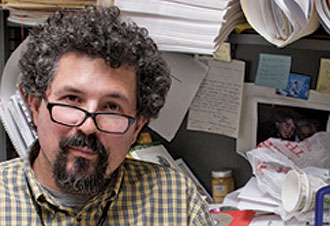Oberlin Alumni Magazine
Summer 2012 Vol. 107 No. 3

(Photo by Matthew Lester)
From the Editor
Stories from the Heart of the Civil Rights Movement
Our cover story in this issue is not a story, and it's certainly not the story, of civil rights. It's many stories, and not all of them. Even the archive of first-person accounts gathered for this article, which will soon be part of a digital archive housed at the Oberlin College Archives website, isn't the whole story.
Where would we begin to tell the whole story? At Oberlin's race-blind founding? The Oberlin-Wellington rescue? The groundbreaking work of Vernon Johns '18? Would we begin in the north or in the south, in the college or in the town? Telling history is about memory and perspective, and those things tend to shift over time.
The most fertile period of civil rights activism for places like Oberlin — liberal arts colleges situated in the north — was the early and mid-1960s, and that is the focus of the article compiled so wonderfully by EJ Dickson '11, who poured her heart into her research and writing and came away touched and inspired by the experience. The subsequent emergence of black power and antiwar movements, in Oberlin and nationally, pushed aside the nonviolent challenge to segregation, discrimination, and white supremacy that was the focus of the traditional civil rights movement. That next phase is, perhaps, a story for another day, another issue.
Oberlin History by Geoffrey Blodgett '53 reminds us that after the Civil War and until the turn of the 20th century, Oberlin went through a particularly dismal period of discrimination and bigotry. Oberlin Review headlines at any point in history — including today — offer evidence that issues around race are never far from the surface. In this issue's letters to the editor, you'll read a range of reactions to the essay we ran in our last issue by Oberlin professor Kazim Ali, an Indian of Middle East ancestry, that chronicled what happened after he set out a box for recycling at his previous place of employment. Clearly we in the Oberlin community do not speak with one voice on issues of race.
But discussions of such issues are and should be lively on our campus, as they are anywhere people struggle to inch honestly toward justice. Perhaps that's what Henry Louis Gates, Jr. was talking about when he wrote in last year's Life Upon These Shores: Looking at African American History 1513-2008, "No college or university in the United States can match Oberlin College's legacy on race."
I remember a discussion session for Adrienne Jones' Black Women in America class held in Tappan Square one sunny afternoon in the mid-1980s. The conversation reached a heated point, and then something odd happened: Even though students said things that might, in another context, be called out as racist or insensitive, the judgment seemed to have fallen away and along with it much of the heat. It seemed that what was missing until then wasn't everyone finally coming to the same conclusion, but people speaking truthfully and openly about their thoughts and feelings about race. The conversation continued even after Professor Jones dismissed the class and excused herself. I don't know about anybody else, but to me it felt like progress.
We have a long way to go, but we won't get anywhere without talking. Perhaps this story — these stories — will help to keep the conversation going.
Jeff Hagan '86
Editor, Oberlin Alumni Magazine
Oberlin Alumni Magazine welcomes comments from readers.
Please address your letters to:
Oberlin Alumni Magazine,
247 W. Lorain St., Suite C,
Oberlin, OH 44074-1089
Phone: 440.775.8182 or email alum.mag@oberlin.edu.
Letters may be edited for clarity and space.
